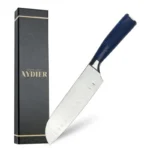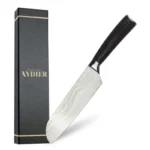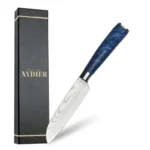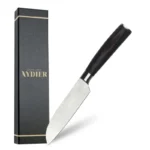Santoku Knives

A Japanese Classic for Modern Kitchens
Santoku knives are among the most versatile Japanese knives, designed to handle everyday cooking tasks with ease. The word Santoku translates to “three virtues,” referring to slicing, dicing, and chopping. With its shorter blade, straighter edge, and slightly curved tip, the Santoku offers precision and control. It has become a favorite tool for both home cooks and professionals.
Design and Features
Unlike a traditional Western chef’s knife, Santoku knives are usually lighter and thinner, with a blade length between 5 and 8 inches. The flat edge and sheepsfoot profile make them ideal for quick, clean cuts without the need for rocking motions. Many models feature a granton edge, which helps reduce friction and prevents food from sticking to the blade.
Materials vary across models. Stainless steel Santoku knives are popular for their durability and low maintenance. High carbon steel offers sharper edges and excellent cutting performance. Damascus steel combines strength with an eye-catching layered design. Each type has different benefits depending on whether you value edge retention, rust resistance, or ease of sharpening.
Everyday Uses in the Kitchen
Santoku knives are especially practical for preparing vegetables, boneless meats, and fish. Their balance and sharpness make them suitable for thin slicing, precise dicing, and chopping herbs or garlic with speed and accuracy. For cooks who prefer light handling and precision over heavy-duty cutting, a Santoku often becomes the main knife on the cutting board.
Choosing the Right Size
Blade size plays an important role in comfort and versatility. A 7 inch Santoku is the most common option and offers balance for most users and tasks. Smaller 5 inch versions are excellent for detail work such as mincing shallots or cutting small fruits. Larger 8 inch models provide more reach for bulkier ingredients. The best choice depends on your hand size, cutting style, and the types of ingredients you prepare most often.
Care and Maintenance
Proper care ensures the longevity of your Santoku knife. Regular honing keeps the edge aligned. Sharpening with a whetstone restores sharpness when needed. Hand washing is recommended to protect the blade from corrosion, and safe storage in a knife block or sheath helps prevent unnecessary wear. With consistent maintenance, a Santoku knife can last for many years while staying sharp and reliable.
Why Add a Santoku to Your Collection
Whether you already own a chef’s knife or are starting fresh, Santoku knives bring efficiency and precision to daily cooking. They are lightweight, easy to handle, and versatile enough to cover most kitchen needs. A Santoku is the perfect mix of Japanese tradition and modern practicality.



